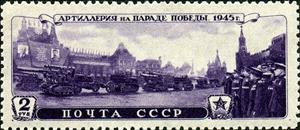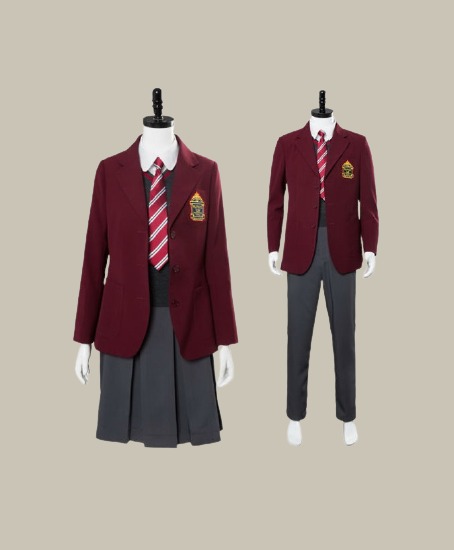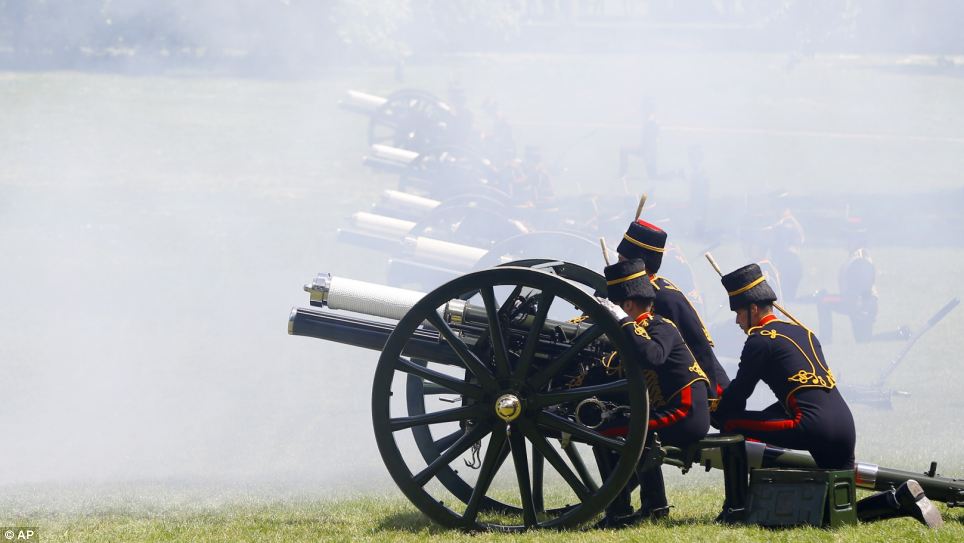Stamp: Artillery on Red Square (Soviet Union, USSR 1946)
Artillery on Red Square (Soviet Union, USSR 1946)
01 January (Soviet Union, USSR ) within release 10th Death Anniversary of Maxim Gorky goes into circulation Stamp Artillery on Red Square face value 2 Russian ruble
| Stamp Artillery on Red Square in catalogues | |
|---|---|
| Michel: | Mi:SU 1012 |
Stamp is square format.
Also in the issue 10th Death Anniversary of Maxim Gorky:
- Stamp - Medal "For Valiant Labour in the Great Patriotic War" face value 30;
- Stamp - Medal "For Victory over Germany in the Great Patriotic War" face value 30;
- Stamp - Medal "For Valiant Labour in the Great Patriotic War" face value 60;
- Stamp - Medal "For Victory over Germany in the Great Patriotic War" face value 60;
- Stamp - Long Live Our Victory! face value 60;
- Stamp - Coat of Arms of the Soviet Union face value 30;
- Stamp - Spasskaya Tower of the Moscow Kremlin face value 45;
- Stamp - Coat of Arms of the Soviet Union face value 60;
- Stamp - Artillery on Red Square face value 60;
- Stamp - Artillery on Red Square face value 2;
- Stamp - Victory parade on Red Square face value 3;
- Stamp - Pafnuty L. Chebyshev (1821-1894), Russian mathematician face value 30;
- Stamp - Pafnuty L. Chebyshev (1821-1894), Russian mathematician face value 60;
- Stamp - Order of Lenin face value 60;
- Stamp - Medal "Hammer and Sickle" face value 60;
- Stamp - Order of the Red Banner of Labour face value 60;
- Stamp - Order of the Red Star face value 60;
- Stamp - Gold Star medal face value 60;
- Stamp - Order of the Badge of Honour face value 60;
- Stamp - Order of the Red Banner face value 60;
- Stamp - Medal for Battle Merit face value 60;
- Stamp - Medal "For the Defence of the Caucasus" face value 60;
- Stamp - Medal "For Labour Valour" face value 60;
- Stamp - Marshal's Star face value 60;
- Stamp - Medal "For Courage" face value 60;
- Stamp - Medal "For the Defence of the Soviet Transarctic" face value 60;
- Stamp - Medal "For the Defence of Moscow" face value 60;
- Stamp - Medal "For Distinguished Labour" face value 60;
- Stamp - Mikhail I. Kalinin (1875-1946), Soviet statesman face value 20;
- Stamp - Sukhumi face value 15;
- Stamp - Gagry face value 30;
- Stamp - Sochi. Riviera Park face value 30;
- Stamp - Novy Afon face value 45;
- Stamp - Maxim Gorky (1868-1936), Russian author face value 30;
- Stamp - Maxim Gorky (1868-1936), Russian author face value 60;
- Stamp - Athletes carrying flags and portrait of Joseph Stalin face value 30;
- Stamp - Medal "For the Defence of the Caucasus" face value 1;
- Stamp - Ivan the Great Bell Tower face value 5;
- Stamp - Bolshoi Theatre face value 10;
- Stamp - Hotel Moskva face value 15;
- Stamp - Sverdlov Square face value 20;
- Stamp - View of the Kremlin from the Moscow River face value 45;
- Stamp - View of Red Square. Saint Basil's Cathedral face value 60;
- Stamp - Monument of Minin and Pozharsky against the Spasskaya Tower face value 1;
- Stamp - Column of tanks on Red Square, Moscow face value 30;
- Stamp - Column of tanks on Red Square, Moscow face value 60;
- Stamp - A wheat sheaf. Combine harvester. face value 5;
- Stamp - Oil field and rigs face value 10;
- Stamp - Transportation of coal. Miner face value 15;
- Stamp - In the steel manufactory face value 20;
- Stamp - Steelworkers at the blast furnaces face value 30;
- Stamp - Soviet stamps on contour map of the USSR face value 15;
- Stamp - 1st Soviet Postage Stamp face value 30;
- Stamp - Images of Soviet stamps face value 60;
- Stamp - Bas-relief "Lenin and Stalin". Spasskaya Tower face value 30;
- Stamp - Bas-relief "Lenin and Stalin". Spasskaya Tower face value 30;
- Stamp - Bas-relief "Lenin and Stalin". Spasskaya Tower face value 30;
- Stamp - Nikolay A. Nekrasov (1821-1878), Russian poet face value 30;
- Stamp - Nikolay Nekrasov (1821-1878), Russian poet face value 60;
- Stamp - The right side of the badge "Laureate of Stalin Prize" face value 30;
- Stamp - Reconstrusting Dam of Dnieper Hydroelectric Station face value 30;
- Stamp - Reconstrusting Dam of Dnieper Hydroelectric Station face value 60;
|
Data entry completed
50%
|
|
|---|---|
| Stamp Artillery on Red Square in digits | |
| Country: | Soviet Union, USSR |
| Date: | 1946-01-01 |
| Perforation: | 12½ |
| Format: | Stamp |
| Face Value: | 2 Russian ruble |
| Print run: | 500000 |
Stamp Artillery on Red Square it reflects the thematic directions:
A head of state (or chief of state) is the public persona that officially represents the national unity and legitimacy of a sovereign state. In some countries, the head of state is a ceremonial figurehead with limited or no executive power, while in others, the head of state is also the head of government. In countries with parliamentary governments, the head of state is typically a ceremonial figurehead that does not actually guide day-to-day government activities and may not be empowered to exercise any kind of secular political authority (e.g., Queen Elizabeth II as Head of the Commonwealth). In countries where the head of state is also the head of government, the president serves as both a public figurehead and the actual highest ranking political leader who oversees the executive branch (e.g., the President of the United States).
A uniform is a variety of costume worn by members of an organization while usually participating in that organization's activity. Modern uniforms are most often worn by armed forces and paramilitary organizations such as police, emergency services, security guards, in some workplaces and schools, and by inmates in prisons. In some countries, some other officials also wear uniforms in their duties; such is the case of the Commissioned Corps of the United States Public Health Service or the French prefects. For some organizations, such as police, it may be illegal for non-members to wear the uniform.
Architecture (Latin architectura, from the Greek ἀρχιτέκτων arkhitekton "architect", from ἀρχι- "chief" and τέκτων "builder") is both the process and the product of planning, designing, and constructing buildings and other physical structures. Architectural works, in the material form of buildings, are often perceived as cultural symbols and as works of art. Historical civilizations are often identified with their surviving architectural achievements.
An army, ground force or land force is an armed force that fights primarily on land. In the broadest sense, it is the land-based military branch, service branch or armed service of a nation or country. It may also include aviation assets by possessing an army aviation component. Within a national military force, the word army may also mean a field army.
A town square (or public square, urban square, city square or simply square), also called a plaza or piazza, is an open public space commonly found in the heart of a traditional town or city, and which is used for community gatherings. Related concepts are the civic center, the market square and the village green.
Artillery are ranged weapons that launch munitions far beyond the range and power of infantry firearms. Early artillery development focused on the ability to breach defensive walls and fortifications during sieges, and led to heavy, fairly immobile siege engines. As technology improved, lighter, more mobile field artillery cannons developed for battlefield use. This development continues today; modern self-propelled artillery vehicles are highly mobile weapons of great versatility generally providing the largest share of an army's total firepower.





